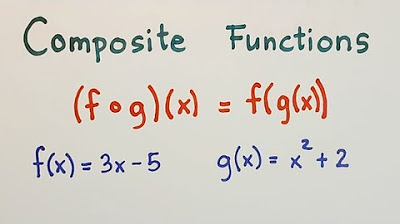Function Operations
Summary
TLDRThe video script explains the operations on two functions, f(x) = 2x + 5 and g(x) = x^2 - 4. It demonstrates how to find the sum (f + g = x^2 + 2x + 1), difference (f - g = -x^2 + 2x + 9), and product (f * g = 2x^3 + 5x^2 - 8x - 20) of the functions. It then discusses the domain of these functions, highlighting that polynomials have a domain of all real numbers, while fractions require excluding values that make the denominator zero. Examples are given to calculate specific values of f and g for certain x inputs, emphasizing the process of substitution and arithmetic operations.
Takeaways
- 🔢 The function f(x) = 2x + 5 and g(x) = x^2 - 4 are given, and their sum f + g results in x^2 + 2x + 1 after combining like terms.
- ➖ The difference f - g is calculated as -x^2 + 2x + 9 by subtracting g(x) from f(x) and simplifying.
- 🔗 The product f * g is found by multiplying the two functions using the FOIL method, resulting in 2x^3 + 5x^2 - 8x - 20.
- 🌐 The domain of f + g, f - g, and f * g is all real numbers since they are polynomials without restrictions.
- 🚫 The domain of f / g is restricted because it involves a fraction; x cannot be the values that make the denominator zero (x ≠ -2, 2).
- 📐 The domain for functions involving fractions is determined by setting the denominator equal to zero to find the vertical asymptotes.
- 📝 Interval notation is used to express the domain of functions with restrictions, excluding the values that make the denominator zero.
- 🔢 To find f(a) + g(b), substitute 'a' into f(x) and 'b' into g(x), then add the results.
- 🔄 To calculate f(a) * g(b), first find the values of f(a) and g(b) separately, then multiply them together.
- 📘 The script provides a comprehensive guide on how to perform operations on functions and determine their domains.
Q & A
What is the function f(x) as described in the transcript?
-The function f(x) is described as f(x) = 2x + 5.
What is the function g(x) as described in the transcript?
-The function g(x) is described as g(x) = x^2 - 4.
How do you find the sum of the functions f(x) and g(x)?
-You add the two functions together, which results in (2x + 5) + (x^2 - 4), and then combine like terms to get x^2 + 2x + 1.
What is the result of f(x) - g(x) according to the transcript?
-The result of f(x) - g(x) is -x^2 + 2x + 9.
How is the product of f(x) and g(x) calculated?
-The product f(x) * g(x) is calculated by multiplying (2x + 5) with (x^2 - 4) using the FOIL method, resulting in 2x^3 + 5x^2 - 8x - 20.
What is the domain of the function f(x) + g(x)?
-The domain of f(x) + g(x) is all real numbers, as it is a polynomial without restrictions.
What is the domain of the function f(x) - g(x)?
-The domain of f(x) - g(x) is also all real numbers, as it is a polynomial without restrictions.
What is the domain of the function f(x) * g(x)?
-The domain of f(x) * g(x) is all real numbers, as it is a polynomial without restrictions.
How do you determine the domain of f(x) / g(x)?
-The domain of f(x) / g(x) is all real numbers except where the denominator g(x) equals zero, which is when x = -2 or x = 2.
What is the interval notation for the domain of f(x) / g(x)?
-The interval notation for the domain of f(x) / g(x) is (-∞, -2) U (-2, 2) U (2, ∞).
What is the value of f(2) + g(3) as described in the transcript?
-The value of f(2) + g(3) is calculated as (4*2 + 5) + (8 - 3^2) which equals 13 - 1, resulting in 12.
What is the value of f(-2) * g(2) according to the transcript?
-The value of f(-2) * g(2) is calculated as (4*(-2) + 5) * (8 - 2^2) which equals (-3) * 4, resulting in -12.
Outlines

This section is available to paid users only. Please upgrade to access this part.
Upgrade NowMindmap

This section is available to paid users only. Please upgrade to access this part.
Upgrade NowKeywords

This section is available to paid users only. Please upgrade to access this part.
Upgrade NowHighlights

This section is available to paid users only. Please upgrade to access this part.
Upgrade NowTranscripts

This section is available to paid users only. Please upgrade to access this part.
Upgrade Now5.0 / 5 (0 votes)





